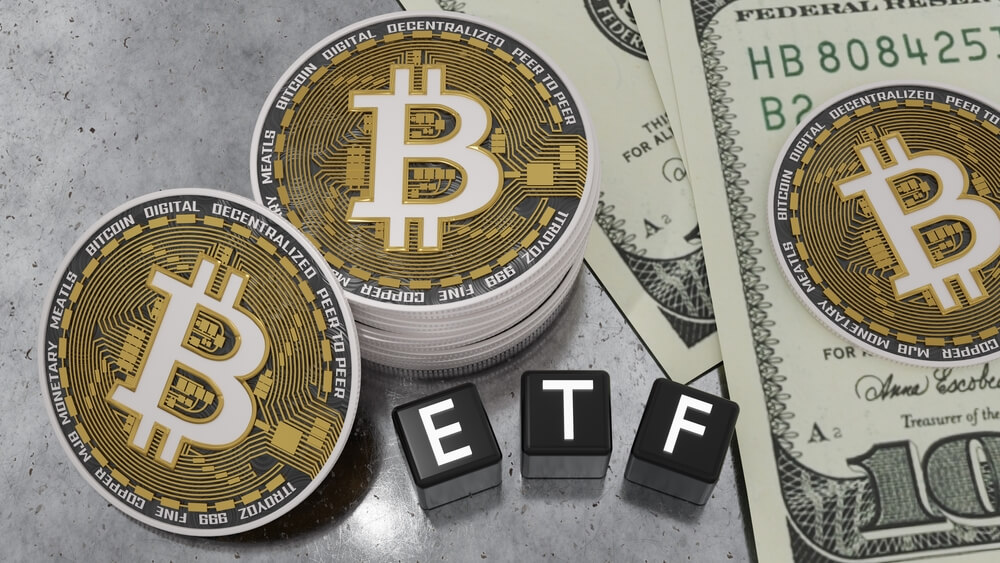
The Most Valuable Gold Coins
Unlike fiat currency, gold is inherently valuable — which is why it’s such a key investment asset. But not everything that’s yellow and glitters is gold. Also, not all gold is valued the same — particularly if those take the “rare gold coin” avatar.

Gold coins that weigh the same and hold equal amounts of the precious metal could have different sticker prices. In other words, the precious gold bullion bars or coins you purchased at a gold dealer may not be as valuable as the coin you accidentally found in your long-lost drawer or coin jar.
But not all old coins are valued greater than their face value. The historical significance, rarity, market demand, and a host of other variables end up ascertaining the true worth — be it with proof coins, a pattern coin, or any gold coin for that matter.
If all of the above sounds like French or you need more clarity in the matter, continue reading. This article would encompass the following for your greater understanding:
- List out the most valuable gold coins doing the rounds
- Explain the logic behind their prices
- Answer some common questions you may have and more.
We know gold coins inside and out, unlike others who talk about gold investing superficially or without real insights. In other words, everything you read below is put together by our industry experts.
Table of Contents
6 Most Valuable Gold Coins
The list below presents the world’s most valuable coins in no particular order. Their values have been ascertained based on their historicity, rarity, design and composition, and, of course, their monetary value.
P.S. The list below is by no means exhaustive and may have omitted some prestigious coins. If it did, the occurrence is by no means indicative of the conspicuously missing coin’s (lack of) worthiness.
$1 Million Gold Canadian Maple Leaf (2007)
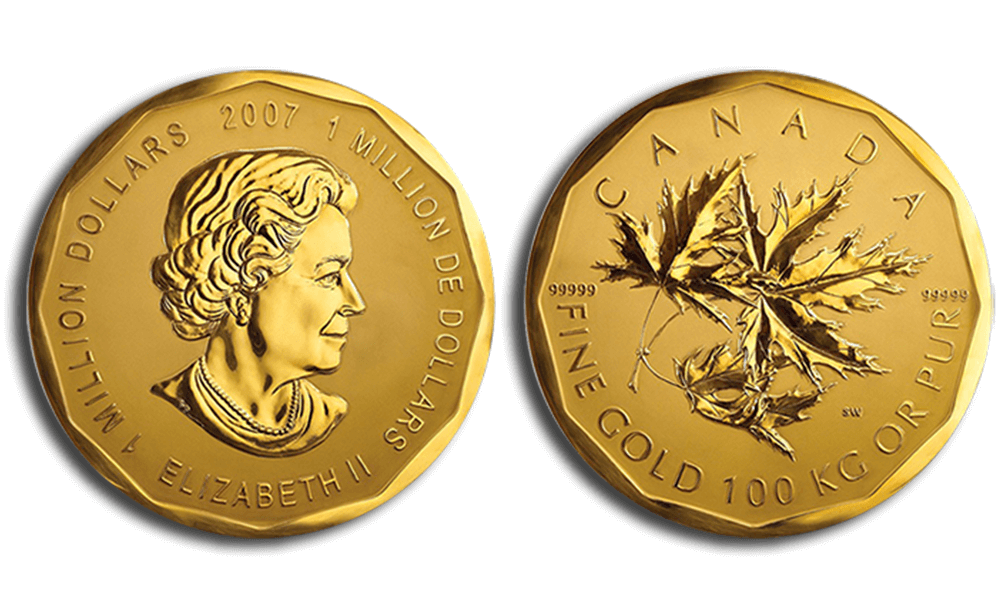
The 2007 Gold Canadian Maple Leaf may not be the scarcest or the most expensive gold coin around, but it’s undoubtedly the biggest and the heaviest. The coin was made to promote a new series of one troy ounce pure gold (99.999%) maple leaf coins minted by the Royal Canadian Mint.
Only six such coins have been made, weighing in at around 220 pounds (100kg) and made of pure gold (99.999%). The coin is 1.2 inches (3cm) thick and 20 inches (50cm) wide. The coin entered the Guinness Book of Records in October 2007, earning the “largest gold coin in the world” tag.
The coin’s front has imagery of Queen Elizabeth II, with the rear showcasing a Canadian maple leaf. Each behemoth is valued at $1 million – which explains the name. However, that’s the sticker price or face value, which will only go up as the coin becomes increasingly desirable. In a 2010 auction, for instance, the coin fetched $4 million (around €3.27 million).
Read More: The World's Purest Gold Coin
Brasher Doubloon (1787)
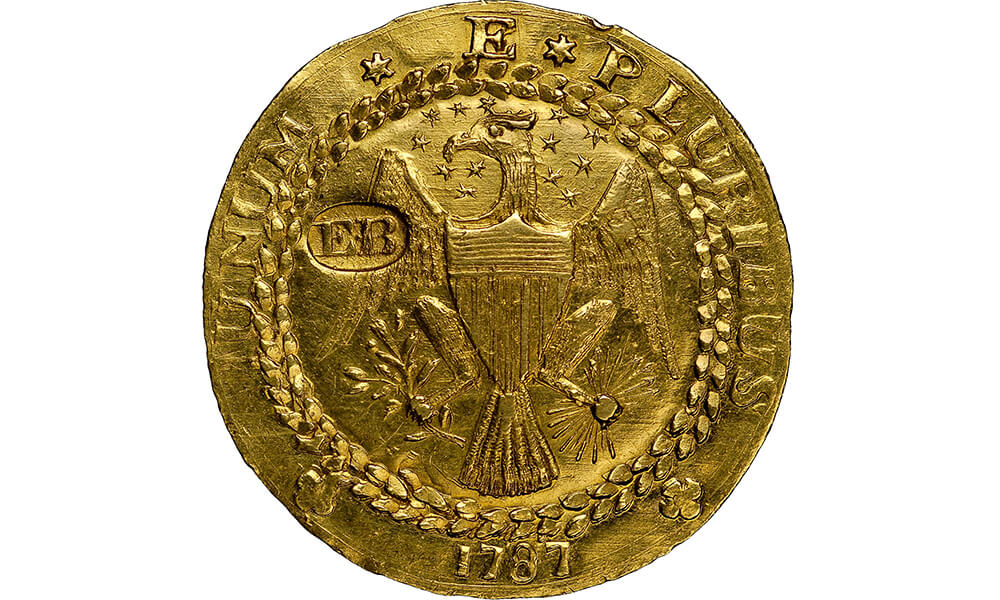
Made by Ephraim Brasher, an NYC goldsmith, the Brasher Doubloon is a coin containing gold worth $15 (in 1787).
The coin’s front features a rising sun and a state seal. The rear side sports the American eagle. The coin is rare and has its versions, differing mainly in the way they are signed. And those variants could fetch different prices in the collector market.
A Brasher Doubloon with the Brasher sign on the breast was sold for close to $7.4 million in 2011. In a private sale conducted in 2018, another Doubloon was sold for more than $5 million. That variant, however, sported the Brasher sign on the inscribed eagle’s wing.
The exact location of the signature quite clearly plays a role in how much money the coin ends up raising.
Saint-Gaudens Double Eagle (1933)
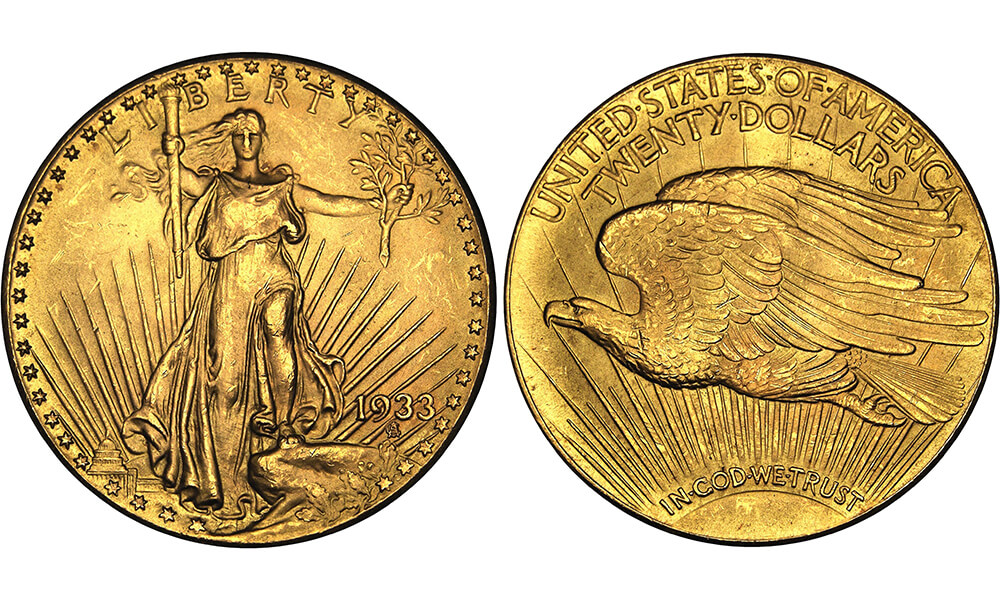
Featuring a flying eagle on one side and a Liberty on the front, the Double Eagle is arguably the most valuable gold coin globally. A scarce Double Eagle gold coin fetched $18.9 million in June 2021 at a New York auction — the highest among all valuable coins in the world, let alone gold coins.
The 1933 edition, carrying a $20 face value, never entered circulation. The majority of the ones minted (approximately 445,000) headed back to the state and were subsequently melted down. A few escaped that fate and managed to show up in the market. As the coins weren’t meant to be among the public, any coin in possession of an individual or non-government entity was considered stolen.
The coin mentioned above, sold for almost $19 million, is the only coin that a person or private entity could legally possess. Before being sold for a record price, the coin had changed hands earlier for $7.6 million in 2002. King Farouk of Egypt originally owned the coin.
Edward III Florin (1343)
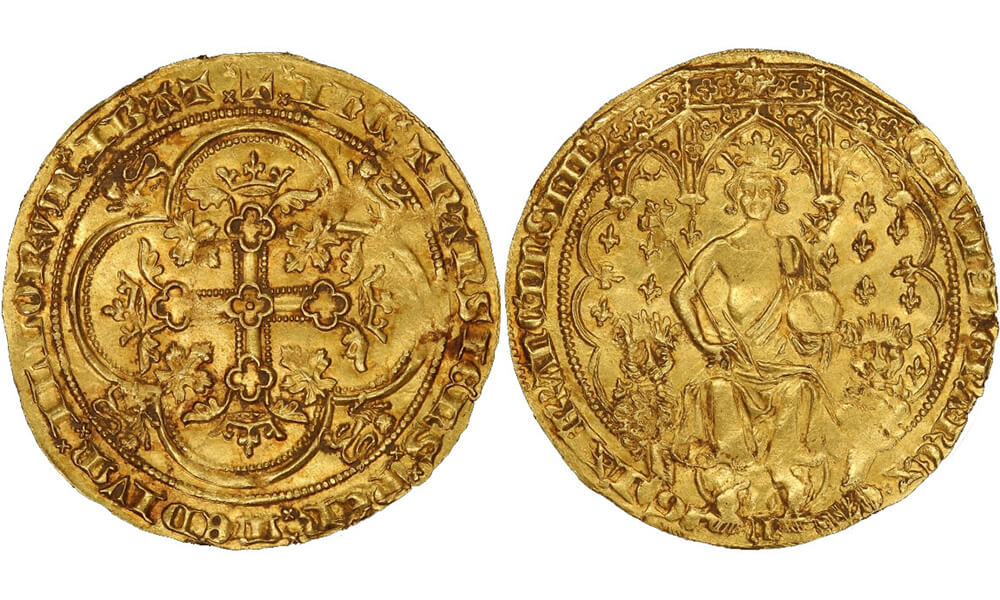
The Edward III Florin is the oldest coin on this list. There are only three Edward III Florins available. Two of them are safely housed in London’s British Museum. The third one was found in 2006 with a metal detector, subsequently sold for $850,000. Its current valuation would be around $6.8 million.
Struck from 7 grams of fine gold and bearing a face value of 6 shillings, the coin’s front showcases King Edward II seated on his throne, flanked by a leopard head on both sides. The rear features the Royal Cross within a quatrefoil (a decorative element). Thanks to its design, the coin is also referred to as the “double leopard” or just “leopard”.
Edward III devised the coin to ensure it would be suitable for use both in England and Europe. For its value, the Florin was underweight, causing its withdrawal from circulation within only a few months of its issue. The noble coin eventually replaced it.
The 723 Umayyad Gold Dinar
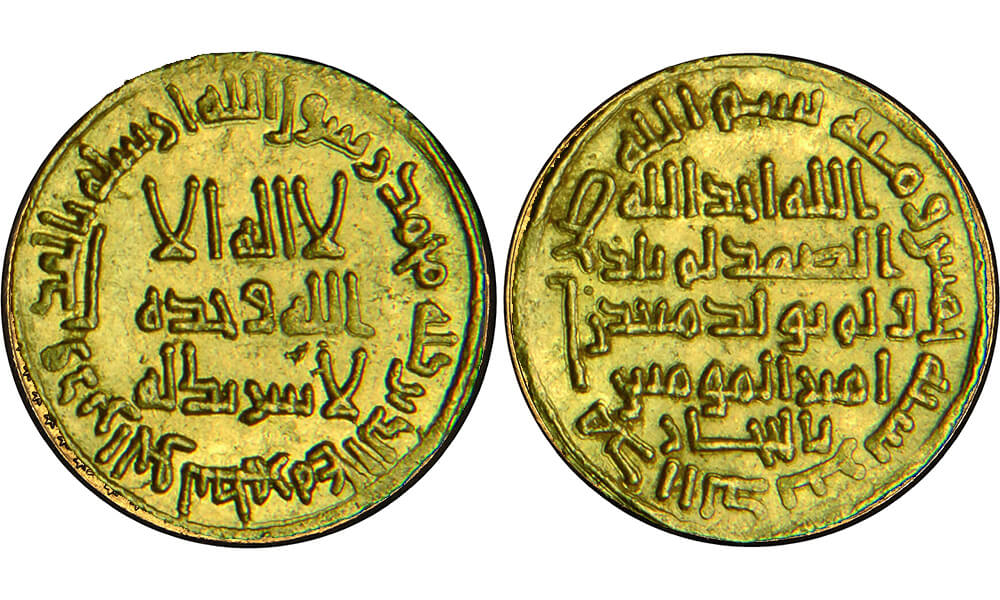
Arguably the most coveted Islamic coin, the 723 Umayyad gold dinar was struck during the rule of the ninth Umayyad caliph Yazid II. The coin has the inscription “Ma’din Bani Sulaim”, which means “Mine of the Commander of the Faithful”.
Close to a dozen Umayyads exist. In 2011, an Umayyad fetched around $6 million at an auction. Another variant was sold for $4.8 million in 2019. The coin got sold for 3.7 million pounds both in 2011 and 2019. But due to the conversation rate discrepancies between the pound and dollar, the sum the 2019 variant got sold for was effectively lower in dollars.
There are close to a dozen Umayyad gold dinars in existence. Similar dinars usually sell for only a few hundred dollars. Because the Umayyad dinar names a present-day Saudi Arabian location and has indirect references to the Prophet Muhammad, it’s worth significantly more. There are, of course, a few other factors contributing to the value.
1822 Half Eagle
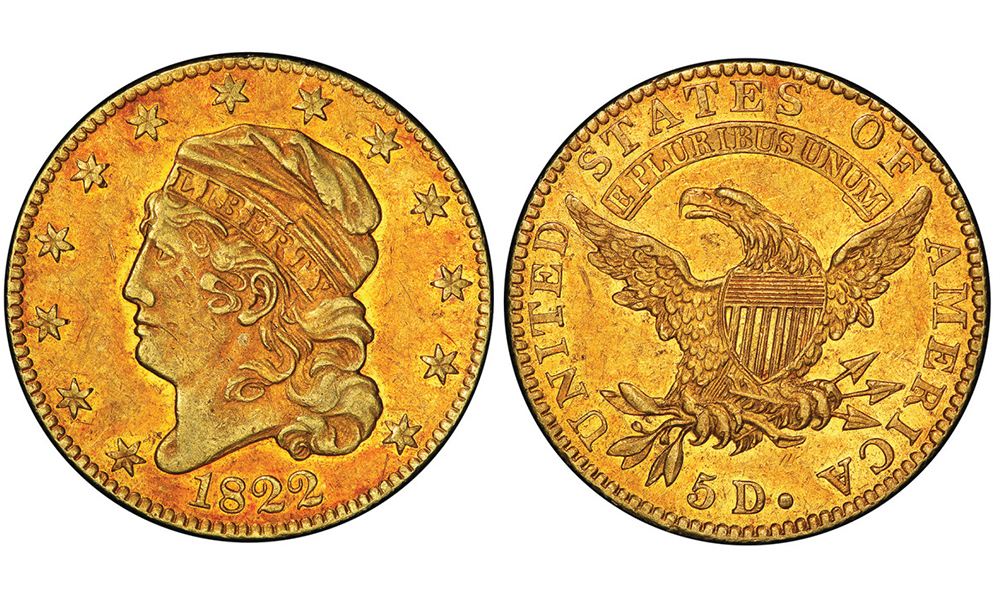
Sold for $8.4 million during an auction in March 2021, the 1822 Half Eagle with a $5 face value is one among the few Unites States mint-produced gold coins to fetch such a massive amount at an auction. The coin trailed only the Brasher Doubloon (sold for $9.36 million) and Flowing Hair Silver (sold for $10 million) until then. The gold coin’s front features a capped bust and an eagle on its rear.
There are only three 1822 Half Eagles, including the one sold. The Smithsonian Institution’s National Numismatic Collection holds the other two coins permanently, which explains why the only one available for grabs commanded such a massive price. The Half Eagle sold had the AU50 grading, which means it was pretty much never in circulation.
First acquired in 1899 by Virgil Brand, Brand’s heirs sold the coin in 1945 to Louis E. Eliasberg, Sr. In 1982, D. Brent Pogue, a famous collector, bought the coin at an auction and kept possession until his death in 2019. If Mr. Pogue had been alive, the coin would have most likely not come up for sale. But it would have still been worth millions or among the most valuable gold coins in the world.
How Do Uncirculated Coins Compare to Proof Coins?
The U.S. Mint manufactures different types of coins. Primarily, there are four coin types: circulating, uncirculated, proof, and bullion coins. (We’ll not be discussing currency and bullion coins here).
Contrary to general perception, the different pennies the U.S. Mint makes differ from each other at the manufacturing phase itself. The disparities in the materials used and the designs come in only later.
What is an uncirculated coin? An uncirculated coin is modeled after every coin that enters circulation during a given year. Uncirculated coins are not meant for use as fiat money and are packaged specially for collectors. But it’s not wrong or illegal to use it as currency. Not to mention, uncirculated coins are highly collectible.
The United States Mint has been producing uncirculated coins since 1947. Because the coins are “uncirculated”, they are usually devoid of scratches and usage marks typically identified with circulating coins. That implies the uncirculated variants are almost always in mint condition.
All of the above might indicate proof and uncirculated coins are the same. But that’s not the case. The following are ways in which the two differ:
Manufacturing
Uncirculated coins are struck the same way as circulated coins but on specialty blanks or specially burnished blanks. The brilliant uncirculated coins are specially treated to achieve their trademark matte-like, soft appearance.
The coins are subjected to a marginally higher coining force, special cleaning post-stamping, and early die striking. When compared to proof coins, uncirculated coins aren’t hand-polished, and the inspection process is usually not as meticulous.
The Looks and Grading
Compared to proof coins, uncirculated coins are not as flashy, but they certainly do not look typical.
Unlike proof coins, uncirculated coins have an identical finish on both sides. They have a sheen to them, which sits somewhere between “glossy” and “frosted”. And because the coins do not undergo rigorous inspection, a blemish or two cannot be completely ruled out.
Like proof coins, uncirculated coins are also graded for their physical condition. The grading system or range starts from AG-3 (About Good) to MS-70 (Perfect Uncirculated).
Cost of Purchase
Typically, proof coins are considered superior or higher than the most fancy-looking or most brilliant uncirculated coins.
Besides the appearance, the fact that a proof coin is made in lesser numbers than an uncirculated coin is also why proof coins come for a slight premium. If you were curious, fewer proof coins are made each year due to their complex manufacturing requirements.
The making process brings down production volumes, and the intricacies attached to the making also mean the requirement for highly-skilled, aka expensive labor. The maker’s margins are also higher on proof coins.
Read More: How DId Gold Become Valuable
Conclusion
Purchasing a gold coin less for the love of coin collecting and more for its historicity is like buying a luxury watch less for its design and more for the assumed appreciation of its value. Like high-end watches, it can be pretty challenging to guestimate the gold coins that would increase in value and the ones that will stay worthy for their materials alone.
The above-mentioned gold coins are precious as they have proven their worth over a period or boast a history that most of their counterparts cannot. Accessibility could be an issue with them, however. Even if you can buy them, they could be extremely pricy. Whether to purchase or let them pass at the asking price is a decision for you to take.
Long story short, it’s recommended you purchase rare gold coins if you are into the hobby and have a lot of cash lying around doing nothing. If that doesn’t sound like your financial situation and you still want to invest in gold (perhaps for retirement), a gold IRA is recommended. Click here to learn more about the self-directed IRA.
The Most Valuable Gold Coins FAQs
What causes some valuable gold coins to become highly desirable?
There’s no straight answer to why some precious metal coins go up in value. Besides numismatic significance, one could ascribe the demand for gold coins and coins made of other precious metals to the rise in the number of millionaires and billionaires across the globe.
When people have millions to spare, they tend to put that money in items that symbolize their wealth and status. Like art, yachts, rare sports memorabilia, real estate, etc., gold and silver coins also tend to grab their fancy. The rarer, ancient, and “controversial” the item, the greater is its desirability. That perhaps explains the insane money the 1933 Double Eagle went for at an auction.
Do you recommend investing in gold coins?
Like stock, the price of valuable gold coins is influenced by multiple aspects. The coins mentioned above are outliers or worth millions because they have desirable traits that most other valuable gold coins do not possess.
That said, the above coins are “rare” in the truest sense and also may not be accessible or within reach of most gold coin buyers. Therefore, if you are buying your first gold coin or building a collection of coins, do that out of sheer interest or the love for collecting coins.
If you approach the hobby purely from an investment angle, you could grow impatient and may even end up disappointed. In that case, you might as well invest in stocks, bonds, real estate, etc.
How to detect fake gold coins or coins that aren’t worth their asking prices?
Because the business of buying and selling gold coins is so lucrative, several nefarious individuals try to sell precious metal coins for an inflated price at auctions. Worse yet, some try to sell fake gold as real on sites such as eBay.
To steer clear, do not buy gold online — unless and until the site is reputable. If the site is purely into selling collector/luxury items, such as Sotheby’s, go ahead with closed eyes. Any dealer or numismatist recognized by the Professional Numismatics Guild (PNG) and the American Numismatic Association (ANA) is also safe to deal with.
Do your research always. If you are willing to put down hundreds and thousands of dollars on a particular coin, it certainly pays to spend some quality time learning more about the coin and its numismatic rarity.
Are there “proof notes”?
Proof or specimen banknotes exist too. However, they are not as collectible or desirable since they are only made of paper. In other words, they carry no melt value. Besides not being intrinsically valuable, unlike gold and silver, paper can also deteriorate at an accelerated pace — particularly if not taken good care of.


